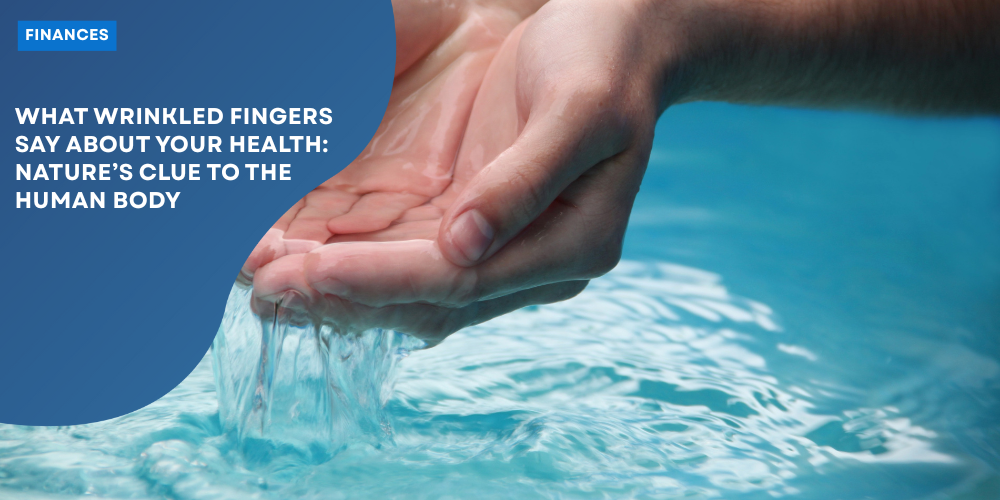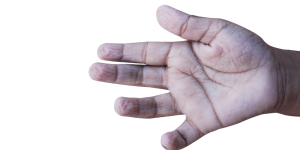What Wrinkled Fingers Say About Your Health: Nature’s Clue to the Human Body

Anúncios
Why do our fingers wrinkle in water—and what can it say about your health?
After just a few minutes in a hot bath or swimming pool, the skin on our fingertips and toes begins to wrinkle.
While it may seem like a harmless quirk, this biological response is actually more complex than most people realize.
In 2025, new scientific research has expanded our understanding of this wrinkling effect, linking it to nervous system activity, evolutionary adaptation, and even signs of underlying health issues.
This common occurrence might hold more insight into human health than previously imagined.
Anúncios
Moreover, as wearable health technologies advance, interest in non-invasive indicators like skin response to water is increasing.
Researchers hope that one day, simple behavioral patterns—such as how quickly one’s skin wrinkles—can be used as early indicators in digital health assessments, adding another layer of preventive care to everyday life.
How Finger Wrinkling Happens
- Wrinkling usually begins after 3 to 10 minutes of soaking, depending on water temperature. At 40°C (104°F), it starts quicker; at 20°C (68°F), it takes longer.
- The maximum wrinkling effect is typically reached after about 30 minutes of immersion.
- Traditionally, it was believed this was caused by osmosis—water entering the upper skin layers. However, as early as 1935, scientists suspected something more complex.
Doctors found that patients with damage to the median nerve—responsible for many autonomic functions like sweating—did not show normal wrinkling.
This led to the theory that the nervous system plays an active role in this process.
In fact, further research indicates that not only does wrinkling depend on nerve function, but that the vascular constriction associated with the effect may also be influenced by factors like hydration levels, temperature sensitivity, and even stress.
Anúncios
Latest Discoveries Behind the Mechanism
In 2003, neurologists in Singapore observed that applying a local anesthetic cream, which induces vasoconstriction, created similar wrinkles as water exposure.
This pointed to a connection between blood flow regulation and finger wrinkling.
When fingers are immersed in water, sweat ducts open, allowing water in. This alters the salt balance in the skin, which activates nerve endings that cause blood vessels to constrict.
As blood flow reduces, the underlying tissue shrinks, pulling the skin downward and causing wrinkles.
Biomechanical engineer Pablo Saez Viñas explains that both skin swelling and underlying tissue contraction must occur for the wrinkling pattern to appear.
Without this neurological response, normal wrinkling is inhibited.
Further computer simulations are now helping scientists visualize how skin folds and anchors respond at the microscopic level.
These insights may eventually lead to breakthroughs in prosthetic design or robotics—by replicating the adaptive texture of wrinkled skin to improve artificial grip mechanisms.
Is Finger Wrinkling an Evolutionary Advantage?
If this response is neurologically controlled, it’s not random—it may serve a purpose.
Neuroscientist Nick Davis, prompted by his child’s curiosity, studied whether wrinkled fingers improved grip.
His team found that volunteers with wrinkled hands had better grip on wet objects than those with unwrinkled ones.
This increased surface friction allowed for more secure handling with less muscular effort.
Other studies confirmed these results. In one, volunteers transferred submerged marbles and weights.
With wrinkled fingers, they completed the task 12% faster compared to when their fingers were wet but unwrinkled.
Some researchers suggest these wrinkles act like tread on tires or shoe soles, channeling water away from contact points to increase grip.
This may have helped ancient humans traverse wet terrain or collect aquatic foods like shellfish.
Since the effect is slower in saltwater, scientists theorize the trait evolved in freshwater environments.
Interestingly, field anthropologists have begun comparing populations with different water-related subsistence practices—such as river fishers vs. coastal gatherers—to assess whether cultural behaviors influenced the degree of this trait’s evolution.

| 🧬 Condition | Wrinkling Pattern | What It Indicates |
|---|---|---|
| 🩸 Type 2 Diabetes | Reduced or delayed wrinkling after water immersion | Possible nerve or blood vessel dysfunction |
| 🧫 Cystic Fibrosis | Excessive wrinkling on palms and fingers | Abnormal salt transport in the skin |
| ❤️ Heart Failure | Diminished wrinkling response | Disrupted autonomic nervous system |
| 🧴 Skin Conditions | Slowed wrinkling in affected areas | May indicate psoriasis or vitiligo |
| 🧠 Parkinson’s Disease | Asymmetrical wrinkling between hands | Potential nervous system irregularities |
Known as the “water-induced wrinkling test,” this non-invasive technique is now used in hospitals and clinics to help evaluate nerve function and autonomic health.
Emerging mobile applications and telemedicine devices are beginning to explore the use of smartphone cameras and temperature sensors to automate this test remotely.
This could prove especially valuable in rural or underserved regions, where access to neurologists and diagnostic imaging is limited.
Why Don’t Fingers Stay Wrinkled?
Even though wrinkled fingers improve grip in wet environments, they return to normal after 10–20 minutes. Why?
Touch sensitivity may be altered during wrinkling. Our fingertips are packed with nerve endings, and changes in skin texture can affect how we perceive surfaces.
Some people find the sensation unpleasant, possibly due to altered positioning of sensory receptors.
This temporary change could explain why we don’t have permanently wrinkled fingers—even if they offer practical benefits in certain situations.
Additionally, maintaining constant wrinkles could increase the risk of skin cracking, reduced flexibility, or microbial growth in skin folds, which might outweigh the advantages in dry conditions.
Evolution likely favored a reversible mechanism that balances both grip and protection.
Lingering Mysteries
Despite advances in 2025, many questions remain unanswered:
- Why does wrinkling only occur on fingers and toes?
- Why do women develop wrinkles more slowly than men?
- Why do wrinkles disappear if they offer improved grip?
- Why haven’t other primates been observed with similar responses?
Japanese macaques have shown signs of wrinkling after hot spring baths, but studies on other primates are limited.
More comparative research is needed to determine if this trait is uniquely human.
It is also unclear whether environmental factors like climate, diet, or skin hydration play a role in the onset and intensity of wrinkling.
Future global health studies may help answer these open questions by collecting diverse data from multiple ethnicities and regions.
Conclusion: A Diagnostic and Evolutionary Clue
What appears to be a simple bodily reaction turns out to be a complex physiological mechanism tied to our nervous system, evolutionary history, and overall health.
Finger wrinkling is not just a curious side effect of bathing—it’s a valuable diagnostic tool and a clue to how our ancestors adapted to their environments.
With continued research in 2025 and beyond, this phenomenon may unlock new ways to monitor and understand human health.
So the next time you notice your fingers pruning in the tub, remember: your body might be trying to tell you something important.
And in the years to come, your wrinkled fingers might just be the simplest test you need for complex answers.






